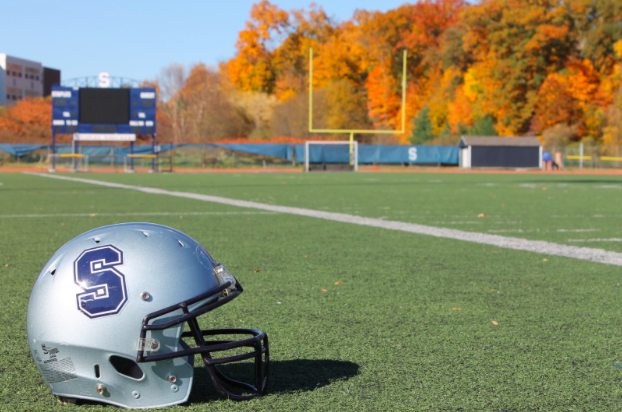Concussions create concerns amongst football players
Concussions are an injury many sports teams will face throughout their season, especially football.
According to the Sports Concussion Institute, it is projected that 53 percent of student athletes have sustained a concussion before participation in high school sports. The brain is at a critical development level before the age of 25 and concussions can affect that development.
“I remember getting one in eighth grade. I was hitting a running back, and we ran at each other head on,” former PAL football player Owen Skinner ’18 said.
USA Football has a Heads-up campaign to make student athletes and their coaches more aware about concussions. All Heads-up coaches must be certified on concussion. This campaign also shows and encourages coaches to teach kids how to tackle, block and run correctly so they do not end up with a head injury.
It is important to have coaches that understand the safety precautions of the student athletes. “I believe great care has been taken into teaching these boys how to hit properly,” Doug Loucas, former PAL football coach of for five years, states, “But I also think that as they get into high school around a third of the guys become more reckless.” All PAL coaches are USA Football certified for coaching.
The players have been also eased into contact drills so they truly understand the importance and safety of correctly tackling. A concern is that since football is the leading cause in male concussions, student athletes do not follow the basic tackling instructions when they get to the high school level. Loucas does not want students to abandon their technique that they learn in favor of aggressiveness.
Though the issue lies with students athletes, Loucas believes the NFL has an impact on the players. “The kids see what the NCAA player and NFL players do and think ‘I want to be like him’. It is unfortunate that the examples are not set at the upper levels,” this further proof that students ignore their technique so they can make the same play that their NFL role models make.
Even though malicious hits lead to penalties and fines in the NFL, Loucas believes it is not enough to stop them from making those hits.
Issues can also be linked to the equipment that is used. Loucas believes that though the equipment has seen great upgrades it still has some way to go. The goal is to make equipment safer and reduce injuries. However, the manufactures have not concluded on the best way to improving on the equipment.
According to USA Today, Guardian Caps believe additional padding on the exterior of the helmet reduces the impact by a third. Whereas Riddell, the official helmet maker of the NFL, created a sensor system in their helmets that transmits impacts based on a player’s history. The sensors registers a value on whether an impact is greater than what that player has registered in the past on tackles and hits.
Programs too have been instituted to lower concussion rates because concussions can have long-term cognitive effects on a person’s life. “People can experience long term effects where they are unable to think clearly, become depressed, experience reoccurring headaches, the inability to focus, or even complete everyday tasks,” Nina Karol, internal medicine physician who routinely treats concussion, explained,
It is clear that there is a common goal to reduce injuries, especially head injuries, in all sports including football. But in the end, there is a still research and knowledge to be found in how to solve this issue.

















































